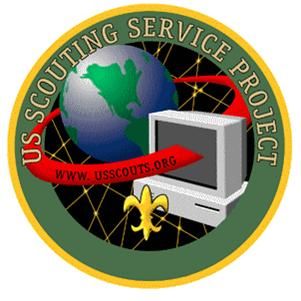General Information
The Guide to Advancement (Publication No. 33088) and information posted on Scouting.org, are the official Boy Scouts of America sources on Scouts BSA advancement procedures. The current edition is the Guide to Advancement 2021
When there is a conflict between two published lists of requirements, such as those posted on Scouting.org and those which appear in a Merit Badge pamphlet or in the Scouts BSA handbooks, the requirements posted on Scouting.org should normally be considered to be the controlling document.
No council, district, unit, or individual has the authority to add to, or to subtract from, any advancement or merit badge requirements. For more detailed information, see the Guide to Advancement, which is available online at www.scouting.org/resources/guide-to-advancementThe following excerpt from the 2021 edition of the Guide to Advancement explains what to do when merit badge requirements change:
7.0.4.3 What to Do When Requirements Change
Merit badge requirements, along with changes to them, can be found at the Scouting.org Merit Badges web page: www.scouting.org/programs/scouts-bsa/advancementand- awards/merit-badges. Once new or revised requirements appears on that page, any Scout beginning work on a merit badge must use the requirement as stated there.
Changes may also be introduced in a revised merit badge pamphlet, youth handbook, or other official BSA publication or release before appearing on the Merit Badges web page. In this case, unless official communications set forth a different procedure or establish a date by when use of the old requirements must cease, youth members have through December 31 of that year to decide what to do. They may continue—or begin work— using the old requirements, or they may switch to—or begin work—using the new requirements. Scouts who choose to use the old requirements may continue using them until the merit badge is completed. Scouts who have not begun work on a badge by December 31 of the year a change in its requirements is announced must use the new requirements.
There is no time limit between starting and completing a badge, although a counselor may determine so much time has passed since any effort took place that the new requirements must be used.
Index of Changes
RANK ADVANCEMENT CHANGESIntroductory note for all ranks
|
||
|
||
SPECIAL OPPORTUNITIES |
||
DISCONTINUED AWARDSThe following awards were discontinued on December 31, 2020. Emergency Preparedness Award On October 12, 2020, BSA announced that the William T. Hornaday Award Program for distinguished service in natural resources conservation had been DISCONTINUED. |
||
|
NEW AWARD On November 9, 2020, the BSA Distinguished Conservation Service Award Program was introduced to underscore the importance of encouraging everyone to participate in environmental stewardship. |
||
Changes to Special OpportunitiesBSA Stand Up Paddleboarding |
Changes to Rank Requirements
Introductory note to all ranksIn 2021, since the Requirements Book was not published, a note which appeared at the start of the Scouts BSA Rank Requirements section of the Scouts BSA Requirements book, was revised, and appeared as an introduction to the requirements for each rank. Since the publication of the Requirements book was resumed in 2022, the note has been restored as a general note introducing the rank requirements for all ranks, minor changes to the note were made, as shown here:
These rank requirements are official as of Jan. 1, 2021 2022. If a Scout has started work toward a rank before that date using requirements that were current before Jan. 1,2021 2022, except as noted below, the Scout may complete that rank using the old requirements. Any progress toward a rank that is begun after Jan. 1, 2021 2022, must use the requirements as they are presented on this webpage scouting.org.
No other changes were made in the requirements book to the requirements for Scout, Tenderfoot, Second Class, First Class, or Eagle Palms.
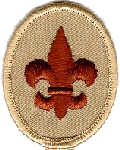 Scout
Scout
Revisions were made, effective on August 1 2022, to requirements 1c, 5, and 6 as shown below.
- Repeat from memory the Outdoor Code. In your own words, explain what the Outdoor Code means to you. List the seven principles of Leave No Trace. Explain the difference between the two.
- Tell what you need to know about pocketknife safety and responsibly.
- With your parent or guardian, complete the exercises in the pamphlet "How to Protect Your Children from Child Abuse: A Parents Guide" and earn the Cyber Chip Award for your grade or view the Personal Safety Awareness videos (with your parent or Guardian's permission). 1
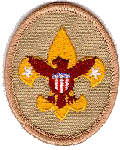 Tenderfoot
Tenderfoot
Revisions were made, effective on August 1 2022, to requirements 1c, 5a, and 5c as shown below.
- Tell how you practiced Explain how you demonstrated the Outdoor Code and Leave No Trace on a campout or outing.
- Explain the importance of the buddy system as it relates to your personal safety on outings and in your neighborhood where you live. Use the buddy system while on a troop or patrol outing.
- Explain the rules of safe and responsible hiking, both on the highway and cross-country, during the day and at night.
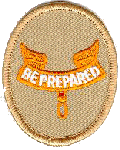 Second Class
Second Class
Revisions were made, effective on August 1 2022, to requirements 1b, 2b, and 2c as shown below.
- Explain Recite the principles of Leave No Trace, and tell how you practiced them on a campout or outing. This outing must be different from the one used for Tenderfoot requirement 1c. from memory. Explain how you follow them on all outings.
- Use the tools listed in Tenderfoot requirement 3d a pocketknife, and a saw or axe if needed, to prepare tinder, kindling, and fuel wood for a cooking fire.
- At Using a minimum-impact method, and at an approved outdoor location and time, use the tinder, kindling, and fuel wood from Second Class requirement 2b to demonstrate how to build a fire. Unless prohibited by local fire restrictions, light the fire. After allowing the flames to burn safely for at least two minutes, safely extinguish the flames with minimal impact to the fire site. Properly dispose of the ashes and any charred remains.
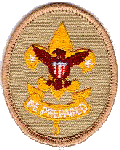 First Class
First Class
Revisions were made, effective on August 1 2022, to requirements 1b and 2d as shown below.
- Explain each of the principles of Tread Lightly! and tell how you practiced them on a campout or outing. This outing must be different from the ones used for Tenderfoot requirement 1c and Second Class requirement 1b. the potential impacts of camping, both on the environment and on other outdoor users. Explain why the Outdoor Code and Leave No Trace principles are important for protecting the outdoors.
- Demonstrate the procedures to follow in the safe handling and storage of fresh meats, dairy products, eggs, vegetables, and other perishable food products. Show how to properly dispose of camp garbage, cans, plastic containers, waste water and other rubbish.
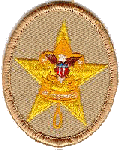 Star
Star
A revision was made to requirement 3, as shown below. Note that Scouts could use Citizenship in Society as one of the Eagle-Required merit badges for Star rank requirement #3 any time after Nov 1, 2021, since it was listed as a required badge in Eagle rank requirement 3, even though the merit badge did not become required for the rank of Eagle Scout until July 1, 2022. There are now a total of 18 merit badges in the list of required badges in Eagle requirement 3.
A revision was made, effective on August 1 2022, to requirement 6 as shown below.
- Earn six merit badges, including any four from the required list for Eagle. You may choose any of the 17 merit badges on the required list for Eagle to fulfill this requirement. See Eagle rank requirement 3 for this list.
- With your parent or guardian, complete the exercises in the pamphlet "How to Protect Your Children from Child Abuse: A Parents Guide" and earn the Cyber Chip Award for your grade or view the Personal Safety Awareness videos (with your parent or Guardian's permission). 7
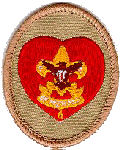 Life
Life
A revision was made to requirement 3, as shown below. Note that Scouts could use Citizenship in Society as one of the Eagle-Required merit badges for Life rank requirement #3 anytime after Nov 1, 2021, since it was listed as a required badge in Eagle rank requirement 3, even though the merit badge did not become required for the rank of Eagle Scout until July 1, 2022. There are now a total of 18 merit badges in the list of required badges in Eagle requirement 3.
- Earn five more merit badges (so that you have 11 in all) including any number more from the list for Eagle so that you have a total of seven from the required list of Eagle in that total number of 11 merit badges. You may choose any of the 17 merit badges on the required list for Eagle to fulfill this requirement. See Eagle rank requirement #3 for this list.
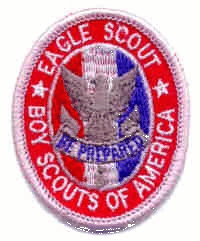 Eagle
Scout
Eagle
Scout
The new Citizenship in Society merit badge was introduced on November 1, 2021, and BSA announced that the new merit badge would become the 14th merit badge required for Scouts to advance to Eagle Scout effective on July 1, 2022. As a result, changes were made to requirement 3 as shown below. The addition of the Citizenship in Society merit badge to the list in requirement 3 took effect on November 1, 2021. The balance of the changes to that requirement all took effect on July 1, 2022. The changes in the Scouts BSA Requirements book were as shown here.
- Earn a total of 21 merit badges (10 more than required for the Life rank), including these 13 14 merit badges:
- First Aid
- Citizenship in the Community
- Citizenship in the Nation
- Citizenship in the World
- Communication
- Cooking
- Personal Fitness
- Emergency Preparedness OR Lifesaving
- Environmental Science OR Sustainability
- Personal Management
- Swimming OR Hiking OR Cycling
- Camping, and
- Family Life, and
- Citizenship in Society
* Citizenship in Society merit badge will be required for the rank of Eagle Scout as of July 1, 2022.
You must choose only one of the merit badges listed in categories h, i, and k. Any additional merit badge(s) earned in those categories may be counted as one of your eight seven optional merit badges used to make your total of 21.
In the list of changes announced in June further changes were made to Requirement 3. In the list of Required badges the Citizenship in Society merit badge was moved fom category n to category d and the badges in categories d-m became categories e-n. That also affected the note as shown below. These changes took effect on July 1 2022.
- Earn a total of 21 merit badges (10 more than required for the Life rank), including these 14 merit badges:
- First Aid
- Citizenship in the Community
- Citizenship in the Nation
- Citizenship in Society
- d. Citizenship in the World
- e. Communication
- f. Cooking
- g. Personal Fitness
- h. Emergency Preparedness OR Lifesaving
- i. Environmental Science OR Sustainability
- j. Personal Management
- k Swimming OR Hiking OR Cycling
- l. Camping , and
- m. Family Life , and
n. *Citizenship in Society* Citizenship in Society merit badge will be required for the rank of Eagle Scout as of July 1, 2022.
You must choose only one of the merit badges listed in categories h, i, and k i, j, and l. Any additional merit badge(s) earned in those categories may be counted as one of your eight seven optional merit badges used to make your total of 21.
NEW Merit Badges
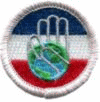 Citizenship
in Society
Citizenship
in Society
This new merit badge was introduced on November 1, 2021. The requirements are as follows.
"Discussion" requirements will be either with a counselor and another individual (in accordance with Youth Protection Guidelines (https://www.scouting.org/health-and-safety/gss/gss01), or with your counselor and a small group (of Scouts), depending upon your preference.
- Before beginning work on other requirements for this merit badge:
- Research the following terms, and then explain to your merit badge counselor how you feel they relate to the Scout Oath and Scout Law:
- Identities
- Diversity
- Equity
- Equality
- Inclusion
- Discrimination
- Ethical Leadership
- Upstander
- Document and discuss with your counselor what leadership means to you. Share what it means to make ethical decisions. Explain what decision and/or options that leader had, why you believe they chose their final course of action, and the outcome of that action.
- Research and share with your counselor an individual you feel has demonstrated positive leadership while having to make an ethical decision. (It could be someone in history, a family member, a teacher, a coach, a counselor, a clergy member, a Scoutmaster, etc.)
- Explain what decision and/or options that leader had, why you believe they chose their final course of action, and the outcome of that action.
- Consider ethical decision-making.
- Think about a time you faced an ethical decision.
- Discuss the situation, what you did, and how it made you feel.
- Share if you would do anything differently in the future and if so, what that would be.
- List three examples of ethical decisions you might have to make in the future at school, at home, in the workplace, or in your community, and what you would do.
- Share how your actions represent alignment with the Scout Oath and Scout Law
- Explain to your counselor how you plan to use what you have learned to assist you when that time comes, and what action(s) you can take to serve as an upstander and help other people at all times.
- Repeat the Scout Oath and Scout Law for your counselor. Choose two of the three following scenarios and discuss what you could do as a Scout to demonstrate leadership and your understanding of what it means to help others who may seem different from you:
- Scenario 1: While at camp, a youth accidentally spills food on another camper. The camper who gets spilled on gets angry and says something that is offensive to people with disabilities; their friends laugh. What could/ should you do?
- Scenario 2: Your friend confides in you that some students in school are making insulting comments about one of their identities, and that those same students created a fake social media account to impersonate your friend online and post messages. What could/should you do?
- Scenario 3: A new student in your class was born in another country (or has a parent who was born in another country). Your friends make rude comments to the student about their speech or clothes and tell the student to "go back home where you came from." What could/should you do?
- Document and discuss with your counselor:
- Ideas on what you personally can do to create a welcoming environment in your Scouting unit.
- An experience you had in which you went out of your way to include another Scout(s) and what you did to make them feel included and welcomed.
- Things you can do to help ensure all Scouts in your unit are given an opportunity to be heard and included in decision-making and planning.
- With your parent's or guardian's approval, connect with another Scout or youth your own age who has an identity that's different from yours. (This means a trait, belief, or characteristic different from you.)
- Share with each other what makes the different aspect of your identity meaningful/special to you.
- Share with each other either one of the following:
- A time you felt excluded from a group.
- What was the situation?
- How did it make you feel?
- What did you do?
- Did anyone stand up for you?
- What did you learn?
- Would you do anything differently today?
- This imaginary situation:
- You're attending a new school and don't know anyone there yet. You notice they dress very differently than you do. At lunchtime, you decide you'll try to sit with a group to get to know other students. People at two tables tell you there is someone sitting at the currently empty seat at their table, so you end up eating by yourself.
- How would that make you feel?
- What could the students have done?
- If that happened at your school, what would you do?
- Discuss with your counselor what you learned from the discussion with the other Scout or youth.
- Identify and interview an individual in your community, school, and/or Scouting who has had a significant positive impact in promoting diversity, equity, and inclusion. If you feel your community, school, or local Scouting group does not have such an individual, then research a historical figure who meets these criteria, and discuss that person with your counselor.
- Discover what inspired the individual, learn about the challenges they faced, and share what you feel attributed to their success.
- Discuss with your counselor what you learned and how you can apply it in your life.
- With the help of your parent or guardian, study an event that had a positive outcome on how society viewed a group of people and made them feel more welcome. Describe to your counselor the event and what you learned.
- Document and discuss with your counselor three or more areas in your life outside of Scouting where you feel you can actively provide stronger leadership in.
- Making others feel included.
- Practicing active listening.
- Creating an environment where others feel comfortable to share their ideas and perspectives.
- Helping others feel valued for their input and suggestions.
- Standing up for others.
- Discuss with your counselor how stereotyping people can be harmful, and how stereotypes can lead to prejudice and discrimination. Share ideas you have for challenging assumptions and celebrating individuality.
- Scouting strives to develop young people to be future leaders in their workplaces, schools, and community environments. As you look at your current involvement in school, your family, Scouting, your job, and/or community, think about how you can have a positive impact in diversity, equity, and inclusion.
- Describe your ideas on how you can and will support others with different identities to feel included and heard at your school, workplace, and/or social settings in your community.
- Explain how including diverse thoughts and opinions from others with different identities can:
- Make your interactions more positive.
- Help everyone benefit by considering different opinions.
- Give three examples of how limiting diverse input can be harmful.
- Give three examples of how considering diverse opinions can lead to innovation and success.
 Health
Care Professions
Health
Care Professions
This new merit badge was introduced on November 15, 2021, and replaced the Medicine merit badge, which has been discontinued. The requirements are as follows.
- Select three of the professions from Group 1 listed below which interest you, then complete the following:
- Briefly describe to your counselor the roles these professionals play in the delivery of health care.
- Describe to your counselor the educational and licensing requirements for the professionals you selected.
Group 1:
- Allopathic physician (MD) — all specialties
- Osteopathic physician (DO) — all specialties
- Podiatrist (DPM)
- Chiropractor (DC)
- Nurse Practitioner (NP)
- Psychologist (PhD or PsyD)
- Optometrist (OD)
- Audiologist (AudD)
- Select three of the professions from Group 2 listed below which interest you, then complete the following:
- Briefly describe to your counselor the roles these professionals play in the delivery of health care.
- Describe to your counselor the educational and licensing requirements for the professionals you selected.
Group 2:
- Physician Assistant (PA)
- Registered Nurse (RN)
- Nurse Midwife (CNM)
- Certified Nurse Assistant (CNA)
- Licensed Practical Nurse (LPN/LVN)
- Nurse Anesthetist (CRNA)
- Pharmacist (PharmD)
- Pharmacy Technician
- Emergency Medical Technician (EMT)/Paramedic
- Select three of the professions from Group 3 listed below which interest you, then complete the following:
- Briefly describe to your counselor the roles these professionals play in the delivery of health care.
- Describe to your counselor the educational and licensing requirements for the professionals you selected.
Group 3:
- Physical Therapist (DPT)
- Occupational Therapist (OT)
- Orthotist/Prosthetist
- Medical Appliance Technician
- Respiratory Therapist (RT)
- Medical Assistant
- Dietitian (RD)
- Speech-Language Pathologist (Speech Therapist) (SLP)
- Select three of the professions from Group 4 listed below which interest you, then complete the following:
- Briefly describe to your counselor the roles these professionals play in the delivery of health care.
- Describe to your counselor the educational and licensing requirements for the professionals you selected.
Group 4:
- Biomedical Engineer (BME)
- Medical Technologist
- Phlebotomist
- Radiology Technologist
- Sonographer
- Medical Records Specialist
- Cytopathologist
- Histotechnologist
- Select one career from any of the lists in Requirements 1, 2, 3, or 4 and arrange to visit that professional at their workplace. Discuss with your counselor the following:
- Why did they choose their particular career?
- What do they most like about their job?
- What are their biggest challenges in doing their job?
- Identify the tools/instruments that may be used in their jobs.
- What has been the most surprising aspect of their career?
- What continuing education requirements are required to maintain certification?
- Discuss with your counselor your understanding of the meaning of the Physician’s Oath.
- Describe the role of confidentiality between a patient and the health care provider. What is HIPAA?
- Identify a medical advancement or discovery that has been in the news recently. Discuss with your counselor how this can affect patient care.
- With approval of your counselor and parents /guardian, serve as a volunteer at a health-related event or facility in your community (e.g. blood drive, health fair, blood pressure screening event). Report to your counselor you did and learned from the experience.
DISCONTINUED Merit Badge
 Medicine
Medicine
This merit badge was discontinued on December 31, 2021, and was replaced by the Health Care Professions merit badge. Scouts that had started working on this badge prior to January 1, 2022, may still earn the badge by continuing to work on the badge, but Scouts may no longer start work on this badge.
REVISED Merit Badges
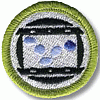 Animation
Animation
A change was made to requirement 3b, as shown below
- Plan your animation using thumbnail sketches and/or layout drawings either on paper or using an animation software program.
 Astronomy
Astronomy
Requirement 1c was split into requirements 1c and 1d, as shown below.
- Describe the proper clothing and other precautions for safely making observations at night and in cold weather. Then explain how to safely observe the Sun, objects near the Sun, and the Moon.
- Explain how to safely observe the Sun, objects near the Sun and solar eclipses.
 Athletics
Athletics
Changes were made to requirements 1b and 3d, as shown below. The correctrion to requirement 1d corrects an editorial error which was made in 2018.
- Show that you know first aid for injuries or illnesses that could occur while participating in athletic events, including sprains, strains, contusions, abrasions, blisters, dehydration, and heat reactions, and concussions.
- At the end of four (sic) three months, review the chart you created for requirement 3b, and discuss with your counselor what progress you have made during training. Tell how your development has affected you mentally and physically.
 Canoeing
Canoeing
Changes were made to requirement 4a, requirement 5c was added, and Requirement 13 was deleted. as shown below.
- Name and point out the parts of a paddle. Explain the difference between a straight and bent-shaft paddle and when each is best used.
- Review the importance of safety and rescue equipment such as a sound signal device, extra paddle, sponge, bailer, bilge pump, rescue sling, ropes and throw bag.
- Discuss the following types of canoeing:
- Olympic canoe sprint
- Flatwater and river touring
- Outrigger
- Marathon
- Freestyle
- Whitewater
- Canoe poling
 Citizenship
in the Nation
Citizenship
in the Nation
The requirements were substantially rewritten. Old requirement 1 was replaced, old requirements 4, 6 and 8 were revised, and old requirements 2, 3, and 5 were renumbered as 7, 5, and 2. Except for old requirements 2 and 3, which were renumbered, all of the former text has been replaced. As a result, none of the old text is shown below. Instead, we have listed the full text of the new requirements.
Note that the text of the last requirement, as it appears in the merit badge pamphlet, and on Scouting.org, has an editorial error, and the last sentence has some duplicative wording. While it reads like this, the text shown in red should be deleted: The correct te xt does appear in the 2022 Scouts BSA Requirements book (33216 - SKU 656269).
"Show your letter, along with any response you receive, to your counselor your letter and any response you might receive to your counselor."
After deleting that text, the sentence should read as shown here:
Show your letter, along with any response you receive, to your counselor."
The revised wording (including the correction noted above) is as follows:
- What is the Constitution of the United States? What does the Constitution do? What principles does it reflect? Why is it important to have a Constitution?
- List the six purposes for creating the United States Constitution set forth in the Preamble to the Constitution. How do these purposes affect your family and community?
- List the three branches of the United States government. Explain:
- The function of each branch of government
- Why it is important to divide powers among different branches
- How each branch "checks" and "balances" the others
- How citizens can be involved in each branch of government.
- Discuss the importance of:
- Declaration of Independence
- The Bill of Rights (the first 10 Amendments to the Constitution) and the 14th Amendment
- The traditional United States motto "E Pluribus Unum".
- Watch the national evening news for five days in a row or read the main stories in a national media organization (e.g., a newspaper or news website) for five days in a row. Discuss the national issues that you learned about with your counselor. Choose one issue and explain how it affects you, your family, and community.
- With your counselor's approval, choose a speech of national historical importance.
Explain:Choose a sentence or two from the speech that has significant meaning to you, and tell your counselor why.
- Who the author was
- What the historical context was
- What difficulties the nation faced that the author wished to discuss
- What the author said
- Why the speech is important to the nation's history.
- Do TWO of the following:
- Visit a place that is listed as a National Historic Landmark or that is on the National Register of Historic Places. Tell your counselor what you learned about the landmark or site and what you found interesting about it.
- Tour your state capitol building or the U.S. Capitol. Tell your counselor what you learned about the capitol, its function, and the history.
- Tour a federal facility. Explain to your counselor what you saw there and what you learned about its function in the local community and how it serves this nation.
- Choose a national monument that interests you. Using books, brochures, the internet (with your parent's permission), and other resources, find out more about the monument. Tell your counselor what you learned, and explain why the monument is important to this country's citizens.
- Name your representatives in the United States Congress. Write a letter to your representative in Congress explaining your views on a national issue. Show your letter, along with any response you receive, to your counselor.
 Climbing
Climbing
A change was made to requirement 1b, as shown below.
- Show that you know first aid for and how to prevent injuries or illnesses that could occur during climbing activities, including heat and cold reactions, dehydration, stopped breathing, sprains, abrasions, fractures, rope burns, blisters, snakebite, concussions, and insect bites or stings.
 Coin
Collecting
Coin
Collecting
Changes were made to requirements 6, 7, and 10a, as shown below.
- Describe the 1999-2008 50 State Quarters® program or the 2010-2021 America the Beautiful Quarters® program. Collect and show your counselor five different quarters from circulation you have acquired from one of these programs.
- Collect from circulation a set of currently circulating current U.S. coins. Include one coin of each denomination (cent, nickel, dime, quarter, half-dollar, dollar). For each coin, locate the mint marks, if any, and the designer's initials, if any.
- Tour a U.S. Mint facility, the a Bureau of Engraving and Printing facility, a Federal Reserve bank Bank, or a numismatic museum or exhibit, and describe what you learned to your counselor.
 Dentistry
Dentistry
Changes were made to requirements 1b and 6d as shown below.
- Show on your drawing where the nerves and blood vessels enter and leave the tooth.
- Write a feature story for your school newspaper on the proper care of teeth and gums. Include in your story how the use of tobacco products can negatively affect a person's oral health.
 First
Aid
First
Aid
Changes were made to the following requirements 4 , 5b, 8c, 10. 11, and 12. Old Item 10 was split into 10a, 10b, and 11.Okd item 11 was deleted, and additional conditions were added to the lists in items 11 and 12. All of the changes are shown below.
- Explain the universal standard precautions as applied to the transmission of infections. Discuss the ways you should protect yourself and the victim while administering first aid.
- With an adult leader. Inspect , inspect your troop's first-aid kit. Evaluate it for completeness. Report your findings to your counselor and Scout leader.
- Tell the dangers in the use of a tourniquet and the conditions under which its use is justified.
Explain when it is appropriate and not appropriate to use a tourniquet. List some of the benefits and dangers of the use of a tourniquet.- Describe the proper application of a tourniquet.
- Do the following:
- Describe the signs and symptoms of an open or closed fracture or dislocation.
- Explain what measures should be taken to reduce the likelihood of further complications of fractures and dislocations.
- 10. Describe the signs and symptoms and demonstrate Demonstrate the proper procedures for handling and immobilizing suspected closed and open fractures or dislocations of the
11. Describe the signs, symptoms, and possible complications and demonstrate care for someone with a suspected injury to the head, neck, or back.
- Forearm
- Wrist
- Hand and Fingers
- c. Upper leg
- d. Lower leg
- e. Ankle
- Describe the signs and symptoms, proper first-aid procedures, and possible prevention measures for the following conditions:
- Anaphylaxis/allergic reactions
- Asthma attack
- b. Bruises
- c. Sprains or strains
- d. Hypothermia
- e. Frostbite
- f. Burns - first, second, and third degree
- Concussion
- g. Convulsions/seizures
- Someone who is unconscious
- h. Dehydration
- i. Muscle cramps
- j. Heat exhaustion
- k. Heat stroke
- l. Abdominal pain
- m. Broken, chipped, or loosened tooth
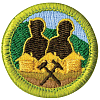 Mining
in Society
Mining
in Society
Requirement 4 was revised as shown below.
- Discuss with your counselor the dangers someone might encounter at an abandoned mine or quarry. Include information about the "Stay out—Stay Alive" program.
 Pioneering
Pioneering
Changes were made to requirements 2a, 2b, 5, 7 and to the note before requirement 9. Rrequirements 3, 8, 9, and 10 were replaced with new requirements 3, 8, and 9. The changes are shown below.
- Demonstrate the basic and West Country methods method method of whipping a rope. Fuse the ends of a rope.
- Demonstrate how to tie a rope tackle and the following knots: clove hitch formed as two half hitches, clove hitch on a bight, butterfly knot, roundturn with two half hitches, and rolling hitch, water knot, carrick bend, sheepshank, and sheet bend.
- Explain why it is useful to be able to throw a rope, then demonstrate how to coil and throw a 40-foot length of 1/4- or 3/8-inch rope. Explain how to improve your throwing distance by adding weight to the end of your rope.
Do the following:
- Using square and tripod lashings from requirement 2c, build a Tripod Wash Station (or with your counselor's permission, another camp gadget of your own design).
- Using rolling hitches or roundturns with two half hitches, and round lashings from requirements 2b and 2c, build a 15-foot Scout Stave Flagpole (or with your counselor's permission, another camp gadget of your own design).
- Using shear, square, and floor lashings, clove hitches on a bight, and rope tackles from requirements 2b and 2c, build a Simple Camp Table (or with your counselor's permission, another camp gadget of your own design.
- Explain the uses for the back splice, eye splice, and short splice. Using 1/4- or 3/8-inch three-stranded rope, demonstrate how to form View a demonstration on forming each splice.
- Explain the importance of effectively anchoring a pioneering project. Describe to your counselor the 1-1-1 3-2-1 anchoring and the log-and-stake anchoring methods system.
- With the approval of your counselor, demonstrate and use a rope tackle. Be sure the rope tackle is secured properly. Explain the advantages and limitations of using a rope tackle. Describe the potential damage that friction can do to a rope.
Describe the lashings that are used when building a trestle, how the poles are positioned, and how X braces contribute to the overall structural integrity of a pioneering project.
- All pioneering projects constructed for this merit badge must comply with height standards as outlined in the Guide to Safe Scouting.
- By yourself, build a trestle using square and diagonal lashings. Explain why trestles are used when constructing pioneering projects.
Working in a group, (or individually with the help of your counselor) build a full size pioneering structure, using one of the following designs in the merit badge pamphlet.Carefully plan the project, assembling and organizing all the materials, referring to the points under Safe Pioneering, and complying with the height restrictions in the Guide to Safe Scouting.
- Double A-Frame Monkey Bridge
- Single A-Frame Bridge
- Single Trestle Bridge
- Single Lock Bridge
- 4x4 Square Climbing Tower
- Four Flag Gateway Tower
- Double Tripod Chippewa Kitchen
- Another type of structure approved in advance by your counselor
- With the approval of your counselor and using appropriate lashings and pioneering techniques, build and use one full-size p ioneering project from either group A or group B. Your project must comply with the requirements of the Guide to Safe Scouting. (Requirement 10 may be done at summer camp, at district or council events, or on a troop camp outing.)
- Group A: Tower OR bridge
- Anchor your project as appropriate and necessary. Explain how your anchoring system works. Group A projects may be worked on in a group and with others.
- Group B: Camp chair OR camp table
- Group B projects must be worked on individually.
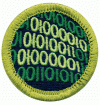 Programming
Programming
The only change made was in the note following requirement 5a. The URL was revised due to the name change from Boyslife to Scoutlife.
The Programming merit badge website, http://www.boyslife.org/programming www.scoutlife.org/programming, has a number of sample programs that you could use for requirement 5a. However, you have the option of finding a program on your own. It's a good idea to seek your merit badge counselor's guidance.
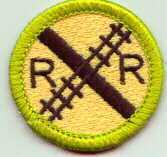 Railroading
Railroading
The following changes were made, as shown below:
Requirement 4 was replaced with 4 and 4a-e, with the old requirement retained
as 4a
Requirement 5 was deleted
Requirement 6 was revised and renumbered as 5 and 5a-f
Requirement 7 was renumbered as 6
Requirement 8 was renumbered as 7 and item b1 was revised
- Explain the purpose of Operation Lifesaver and its mission.
Do the following:
- Explain the purpose of Operation Lifesaver and its mission.
- List 9 track basic safety tips to remember when you are around a railroad track.
- List 9 safety considerations that should be followed when walking near a railroad track.
- Tell your counselor what a driver can do safely operate near tracks.
- Explain safety precautions when using a light rail or commuter train.
- Do THREE of the following:
- List five safety precautions that help make trains safer for workers and passengers.
- Explain to your merit badge counselor why safety around rights-of-way is important.
- List 10 safety tips to remember when you are near a railroad track (either on the ground or on a station platform) or aboard a train.
- Tell your counselor about the guidelines for conduct that should be followed when you are near or on railroad property. Explain the dangers of trespassing on railroad property.
- Tell what an automobile driver can do to safely operate a car at grade crossings, and list three things an automobile driver should never do at a grade crossing.
- Tell how to report a malfunction of grade crossing warning devices.
- List safety precautions a pedestrian should follow at a public crossing.
- 6. Explain the appearance and meaning of the following warning signs and devices: advance warning sign, pavement markings, crossbucks, flashing red lights, crossing gates. rail signs and signals:
- Passive signs and active signs.
- Devices at the crossing (flashing red lights — with or without bells, flashing red lights and gates, and cantilever flashing lights)
- Markings on the road (pavement markings and stop bars)
- Signs before the crossing (advance warning sign, advance warning sign for side streets, no train horn sign, and low ground clearance grade crossing sign)
- Signs along the railroad property (no trespassing sign)
- Signs at the crossing (crossbuck sign, emergency notification system sign, multiple track sign, stop sign, and yield sign).
- 7. Do EACH of the following:
- 8. Select ONE of the following special-interest areas and complete the requirements:
- Visit a railroad museum, historical display, or a prototype railroad-sponsored public event. With permission, photograph, videotape digitally record, or sketch items of interest. Explain what you saw and describe your photos, sketches, or videotape video.
 Reading
Reading
A new requirement 1e was added, and minor editorial changes were made to requirements 3, 3a 4, and 5, as shown below.
- Explain what is a library card, why it is needed, and how to get one.
- Read four different types of books, such as poetry, fiction, nonfiction, or biographies. Do any ONE one of the following for each book you have read:
- Write a review of the book. Include what you liked/didn't like about the book. Include if whether you would recommend this book, and if so, who might enjoy reading it.
- Read a nonfiction book or magazine that teaches you how to do something like cooking, wood-building projects, video game design, science experiments, knot-tying, etc. With your counselor's and parent's or guardian's permission, complete a project from the book. Share your experience with your merit badge counselor. Reading a merit badge pamphlet will not count toward completing this requirement.
- Read about the world around you from any two sources: books, magazines, newspapers, the internet (with your parent's or /guardian's permission), field manuals, etc. Topics may include Scouting, sports, environmental problems, politics, social issues, current events, nature, religion, etc. Discuss what you have learned with your counselor.
 Traffic
Safety
Traffic
Safety
Requirements 2a, 3b, 3c, 3d and 5b were revised, requirements 1c, 3a, and 5b were replaced, and requirement 5d was deleted. The changes are shown below.
- Describe at least four factors to be considered in the design of a road or highway. Explain how roadside hazards and road conditions contribute to the occurrence and seriousness of traffic crashes.
Explain why new drivers are at a significantly higher risk of being involved in a collision than other drivers and name three (3) steps you can take that will reduce this risk.
- Demonstrate how to properly wear a lap or and shoulder belt properly. Explain why it is important for drivers the driver and all passengers to wear safety belts at all times always to wear their seat belts.
- Using your family car or another vehicle, demonstrate that all lights and lighting systems in the vehicle are working. Describe the function and explain why each type of light is important to safe driving.
Using a vehicle that you have access to, demonstrate that all marker lights, parking lights, brake lights, turn signals, and headlights are clear and operational. Explain when you would use these lights, where the switches are to operate these lights and how these lights contribute to safe and courteous driving.- Using your family car or another vehicle, demonstrate how to check tire pressure and identify Using a vehicle that you have access to, demonstrate how to check the vehicle's tire pressure and where to locate the correct tire pressure rating for the vehicle. Explain why proper tire pressure is important to safe driving the safe operation and fuel economy of the vehicle.
- Demonstrate Explain why proper tire tread depth is important to safe driving. On the same vehicle you checked the tire pressure on, demonstrate a method to check for adequate tire tread depth. Explain why proper tire tread is important to safe driving.
- Explain issues that might affect the driver's ability to see through the front, rear, and side windows. Demonstrate with a smear-and-clear test if the windshield wiper blades will clear the windshield completely or need to be replaced. Describe instances in good and bad weather when windshield washers wipers are important to safe driving.
- As a driver, describe Descibe the difference in nighttime visibility between a properly lit bicycle and rider (or a pedestrian) wearing reflective material and a bicycle and rider with no lights (or a pedestrian) dressed in dark clothing, without reflective material.
- Using the internet (with your parent's permission), visit five websites that cover safe driving for teenagers. As a group, discuss what you learn with your counselor and at least three other teenagers.
Write a personal traffic safety pledge, addressing three (3) of your most concerning issues relating to traffic safety. Show your pledge to your merit badge counselor and discuss your commitment to traffic safety.- "Accompanied by an adult and a buddy, pick a safe place to observe traffic at a controlled intersection (traffic signal or stop sign) on three separate days and at three different times of the day, for 30 minutes on each visit. At this intersection, survey violations that might occur. These violations could include (but are not limited to) running a red light or stop sign, speeding, using a cell phone while driving, or occupants not wearing their seat belts. Count the number of violations. Record in general terms the approximate age of the people you observed. Keep track of the total number of vehicles observed so that you can determine the percentage of compliance vs. violations. Discuss your findings with your merit badge counselor.
 Programming
Programming
The only change made was in the note following requirement 5a. The URL was revised due to the name change from Boyslife to Scoutlife.
The Programming merit badge website, http://www.boyslife.org/programming www.scoutlife.org/programming, has a number of sample programs that you could use for requirement 5a. However, you have the option of finding a program on your own. It's a good idea to seek your merit badge counselor's guidance.
NEW Special Opportunity
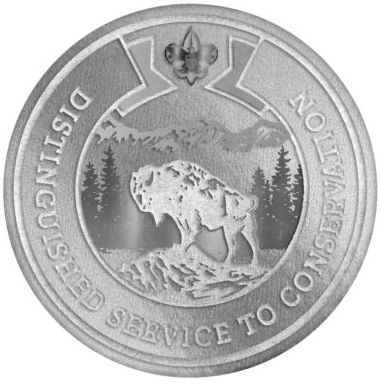 BSA
Distinguished Conservation Service Award
BSA
Distinguished Conservation Service Award
This award was introduced on November 9, 2020, as a replacement for the Hornaday Awards. The requirements for the Award are shown below.
- Earn First Class rank.
- Earn the following five Merit Badges:
- Environmental Science
- Fish and Wildlife Management
- Forestry
- Soil and Water Conservation, and
- Sustainability
- Earn any two of the following Merit Badges:
Bird Study Energy Fishing Fly-Fishing Gardening Geology Insect Study Landscape Architecture Mammal Study Nature Nuclear Science Oceanography Plant Science Pulp and Paper Reptile and Amphibian Study or Weather - Plan, lead and carry out two conservation projects, from two different categories (Categories include Air and Water Pollution Control, Energy Conservation, Fish & Wildlife Management, Forestry & Range Management, Hazardous Materials Disposal and Management, Invasive Species Control, Pollinator Management, Resource Recovery, or Soil & Water Conservation). The projects must be developed under the guidance and pre-approval of the Scout's Unit Leader, a BSA Distinguished Conservation Service Award Adviser and the Council Conservation Committee. One of the projects may include the Scout's Eagle Scout project, if applicable. All projects must contribute to environment improvement on a longterm scale. Applicants must use the BSA Distinguished Conservation Service Award Workbook to document each of the service projects.
- Successfully pass a board of review conducted by the local Council's Conservation Committee.
Temporary awards (the BSA Distinguished Conservation Service Award Bronze Honor and Silver Honor) were developed for Scouts that were working on the William T Hornaday Bronze or Silver Awards and had already completed at least 2 service projects and had started on the 3rd or 4th projects by October 13, 2020. If the Scout met these requirements they had until June 30,2021 to complete the temporary awards. On July 1, 2020, the temporary awards were retired and are no longer available to be earned.
Changes to Special Opportunities
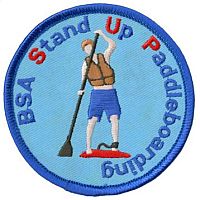 BSA
Stand Up Paddleboarding
BSA
Stand Up Paddleboarding
Requirement 2 was revised by eliminating the details of the BSA Swimmer test..Since the test is still required, the change is simply an editorial revision. Requirement 2 now reads as follows:
- Before fulfilling other requirements, successfully complete the BSA swimmer test: Jump feet first into water over the head in depth, level off, and begin swimming. Swim 75 yards in a strong manner using one or more of the following strokes: sidestroke, breaststroke, trudgen or crawl; then swim 25 yards using an easy, resting backstroke. The 100 yards must be completed in one swim without stops and must include one sharp turn. After completing the swim, rest by floating.
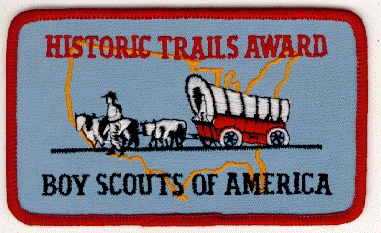 Historic
Trails Award
Historic
Trails Award
Revisions were made to the introductory line, and requirements 1, 3, and 4. In addition, the note following the requirements was deleted. The changes are shown below.
To earn this the award, members of your unit must plan and participate in a historic activity. A unit historic activity requires members to:
- Locate a historic trail or site using https://tap.scouting.org/bsa-historic-trails-index/ or by contacting local councils. Have participating Scouts study . Study materials regarding the historical aspect of the trail or site using council-provided pamphlets, web-based resources, local historic societies, or the library.
- Conduct a substantial service project or trail/site restoration under the supervision or permission of the owner or sponsoring agency of the trail or site. An alternative to a project can be Cooperate with an adult group such as a historic society to restore and mark all or part of this trail or site. (This may be done during the hike or overnight camp.) Or cooperate with such a group to plan and stage a historic pageant, ceremony, or other public event related to this trail or site . Such - such an event should be large enough to merit coverage by the local press.
- Your unit leader must then file the Historic Trails Award application with your local council service center.
(Note: Only chartered units may apply for this award. This award does not apply if any other BSA award is available for this trip.)
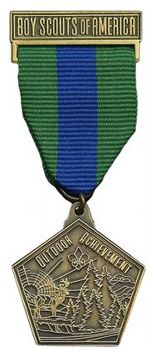 National
Medal for Outdoor Achievement
National
Medal for Outdoor Achievement
Changes were made to requirements 7 and 8a , removing references to "teams" and "squads", which are no linger used in BSA units. The changes are shown below
- Plan and lead, with the approval of your unit leader, an outing for your troop, team, ship, crew, or patrol, or squad in two of the following activity areas: hiking and backpacking, aquatic activities, or riding. Include in each outing a service element addressing recreational impacts resulting from that type of activity. With the approval of your unit leader, you may plan and lead the outings for another Cub Scout pack, Scout troop, Sea Scout ship, or Venturing crew.
- Plan and lead, with the approval of your unit leader, an adventure activity identified in the National Outdoor badge for Adventure for your troop, team, ship, crew, or patrol, or squad.
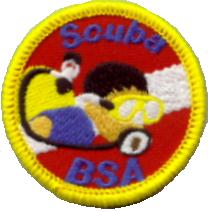 Scuba
BSA
Scuba
BSA
Requirement 1 was revised by eliminating the details of the BSA Swimmer test. Since the test is still required, that change is simply an editorial revision. Changes were also made to requirements 7 and 9, requirement 15 was replaced, and requirement 16 was deleted. In addition, chnges were made to the note following the requirements. The changes are shown below.
- Before doing other requirements, successfully complete the BSA swimmer test. To begin the test, jump feet first into water over the head in depth, level off, and begin swimming. Swim 75 yards in a strong manner using one or more of the following strokes: sidestroke, breaststroke, trudgen, or crawl; then swim 25 yards using an easy, resting backstroke. The 100 yards must be completed in one swim without stops and must include at least one sharp turn. After completing the swim, rest by floating.
- While underwater, demonstrate and recognize the following hand signals:
- Okay?/Okay!;
- Stop;
- Up;
- Down;
- Out of air;
- Come here;
- Ear problem; Ears not clearing;
- Slow down/Take it easy;
- Something is wrong;
- Watch me;
- Check your air supply.
- In shallow water, demonstrate proper compressed air breathing habits; remembering remember to breathe naturally and not hold the breath.
- In shallow water, breathe underwater for at least 30 seconds from an alternate air source supplied by the instructor.
Describe how lo avoid hazardous aquatic life (if applicable to your confined water location).
16. Demonstrate the techniques for a proper ascent.NOTE: The counselor for Scuba BSA must hold an instructor rating and be in current teaching status with PADI, NAUI, SSI or another member of the RSTC in accordance with BSA scuba policies. Instruction must meet the minimum training standards for introductory scuba experiences set by the RSTC and guidelines provided in the Scuba BSA Brochure, No. 13-971 Pamphlet, No. 440-515. BSA scuba policies are also provided in that brochure and also in the Guide to Safe Scouting.
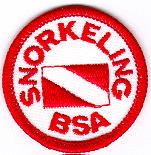 Snorkeling
BSA
Snorkeling
BSA
Requirement 1 was revised by eliminating the details of the BSA Swimmer test. Since the test is still required, the change is simply an editorial revision. Requirement 2 now reads as follows:
- Before doing other requirements, successfully complete the BSA swimmer test. Jump feetfirst into water over the head in depth, level off, and begin swimming. Swim 75 yards in a strong manner using one or more of the following strokes: sidestroke, breaststroke, trudgen, or crawl; then swim 25 yards using an easy, resting backstroke. The 100 yards must be completed in one swim without stops and must include at least one sharp turn. After completing the swim, rest by floating.
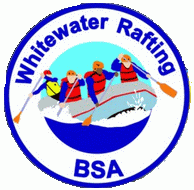 Whitewater
Rafting
Whitewater
Rafting
Requirement 5c was deleted.
- c. Sweep
This analysis was prepared as a service to Scouts and
Scouters nationwide
Paul S. Wolf
Secretary
US Scouting Service Project, Inc.
This document is a product of the U.S. Scouting Service Project, Inc. (USSSP). It may be reproduced by or for Scouting volunteers and used locally for training purposes consistent with the programs of the Boy Scouts of America (BSA), the World Organization of the Scout Movement (WOSM) or other Scouting and Guiding Organizations. However, it may not be used or reproduced for electronic redistribution or for commercial or other non-Scouting purposes without the express permission of the U. S. Scouting Service Project, Inc. (USSSP) or other copyright holders. The USSSP is not affiliated with BSA or WOSM and does not speak on behalf of BSA or WOSM. Opinions expressed in this document are those of the web authors.
A print (PDF) version of this document can be downloaded here.
Printed copies of this document may be freely distributed
for use in the Scouting program,
so long as the source is acknowledged, but copying the information to another
web site is NOT authorized.
© 2020 - U.S. Scouting Service Project, Inc. - All Rights
Reserved
The text and images reproduced herein is © - Boy Scouts of America, and
is used by permission.







